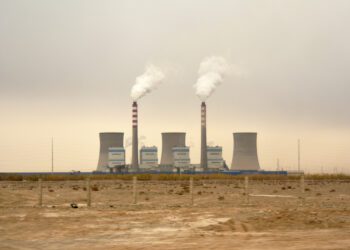Physicists recently announced a history-making milestone in fusion research: They triggered a nuclear reaction that produced more energy than it consumed.
If the results can be replicated, harnessed, and scaled up, then the same stuff that powers stars could eventually provide clean energy for humanity.
That won’t happen overnight; many experts think fusion power plants may be decades away from reality. But according to Paul Dabbar, a distinguished visiting fellow at Columbia University’s Center on Global Energy Policy, it’s possible that we’ll be using fusion to generate electricity in as little as 15 years or so.
Harnessing star power
Fusion is what makes stars like the Sun shine. During fusion, two or more atoms combine to form a heavier atom. The process releases energy that can then be used to fuse more atoms, and so on, making the reaction self-sustaining.
Scientists have long wished to harness this incredibly efficient way of producing energy. While they have been able to recreate fusion in bombs since 1952, the experiment at the Lawrence Livermore National Laboratory’s National Ignition Facility (NIF) is the first to do it in a controlled manner with a net energy gain.
The NIF experiment blasted lasers at two types of hydrogen — deuterium and tritium. The lasers shot 2.05 megajoules of energy at the hydrogen atoms to fuse them into helium, and the reaction released 3.15 megajoules — about 54% more energy than was put in.
The process does not create radioactive waste or greenhouse gas emissions, making it an appealing source of clean energy. Even the starting materials, deuterium and tritium, are relatively easy to come by.
“Fusion is highly efficient,” said Dabbar, who previously worked as the U.S. Department of Energy’s Under Secretary for Science. “It produces no waste in terms of emissions, and has all the positives of other alternative energy sources and none of the negatives.”
Next steps
For all its promise, a lot remains to be solved before fusion will be able to power our homes and charge our electric vehicles.
“It’s a great achievement for humanity, but this is just the first step,” said Dabbar. “It’s important to remember that NIF is a science experiment, not a power plant.”
Dabbar identified several ways that physicists and engineers will need to build on this work in order to make it a viable clean energy option.
For one, the energy production will need to be regular and continuous, as opposed to the single shot of energy shown in the experiment.
Secondly, ideally the net energy gain would be higher than the 54% that the NIF experiment achieved. And there were inefficiencies around the experiment that aren’t accounted for; although the lasers blasted just 2 megajoules of energy at the hydrogen atoms, it required 300 megajoules from the grid to fire the lasers.
“And then you need to wrap a power plant around it, to turn it into usable energy like electricity,” said Dabbar, “and that hasn’t been designed yet.”
Fusion reactions are so strong that they can quickly wear out the reactor materials, presenting a challenge to the longevity of future power plants.
But, said Dabbar, “The biggest challenge was the physics challenge.”
Not all types of fusion rely on lasers for ignition, and it’s possible that other designs will ultimately have better performance.
“It’s good to have a diversity of ideas and efforts,” said Dabbar, who foresees fusion reactors going through several generations of design, prototyping, testing, and improvement — similar to how solar panels have evolved over the past few decades.
An optimistic timeline
Despite all the work that needs to be done, Dabbar is optimistic that within 15 years or so, the first fusion power plants could be operational. His outlook is informed by his past experience and observations in the energy sector.
“Fifteen years ago,” he said, “Solar PV, wind, lithium-ion batteries — none of this really existed economically.” Yet over the past decade and a half, solar panel costs have dropped by 90% while performance increased. The same thing could happen with fusion, said Dabbar.
It helps that the fusion community had been expecting this breakthrough for a while. “Everyone reached a point where it was a ‘when’ not ‘if,’” said Dabbar, “and people were already asking, ‘What do we do next?’” Laboratories and private companies are already exploring materials innovations and power plant designs, and the ignition breakthrough will no doubt attract more money toward solving the next steps, through both government support and private investors.
Despite all of its promise, fusion power plants likely will not arrive in time to singlehandedly solve climate change. Climate scientists have repeatedly made the case that taking action cannot wait. To avoid the worst climate catastrophes, nations need to start dramatically cutting carbon emissions now, not in 15 years.
Solar power, wind power, carbon capture, or fusion? To Dabbar, the obvious choice is ‘all of the above.’
“The best way to manage our energy technology options is not to bet on one thing,” he said. “Fusion is part of a portfolio of many things that we’re working on right now.”
Courtesy Columbia Climate School. By Sarah Fecht. Article available here.












